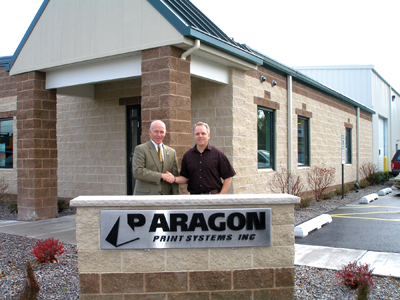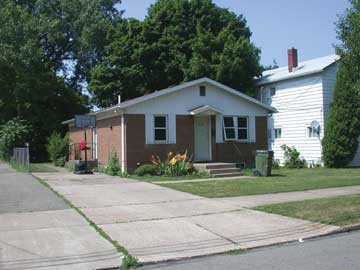Revitalization Program
Neighborhood Revitalization Goals
- Improve the quality of life and the condition of neighborhoods surrounding the John E. Horan Garden Apartments (formerly Franklin Terrace), Harbor Homes, and Eastbrook public housing communities
- Identify public and private partners to participate in neighborhood community development initiatives
- Develop concentrated City code enforcement program for target neighborhoods
- Provide incentives to existing property owners for property rehabilitation
- Create homeownership opportunities for public housing residents
Benefits of Neighborhood Revitalization
- Preservation of several of Erie’s oldest neighborhoods
- Spur increase in property values
- Provide neighborhood “curb appeal”
- Instill a renewed sense of neighborhood pride in area residents
- Provide opportunities for economic growth in the neighborhood
- Provide employment opportunities for area residents

Housing Authority Leads Parade Street Renaissance
The Parade Street Condominiums has its first buyer, a family from Bosnia who chose a three-bedroom condo.
The sale was made after the initial open house, ,which was held in September. Almost 100 people attended.
The Bosnian family, consisiting of a married couple and their two children, got a bargain — $82,175 for the three bedroom unit, said John E. Horan, director of the Erie Housing Authority.
“This family — a father and mother and their two sons, ages 7 and 9 — now have a chance to live the American Dream,” Horan said.
The Parade Stree Condominiums are situated at East 14th and Parade streets.
Although the commercial units are being offered to the general public, as well as Authority tenants, “The Authority intends to give our income-qualified public housing tenants the first opportunity to purchase the residential units,” said Horan. The American Dream of homeownership is coming back to Parade Street. We hope it will spark additional commercial and residential development. This is a large first step in the renaissance of the historic Parade Street corridor.”
The Parade Street development contains six residential and two commercial units. For qualified public housing tenants, the residential units will be available from $58,900 to $87,780, depending upon the size of the condominium.
The 14th and Parade Street site had been vacant for the past 27 years. “This is one of the most significant developments on Parade Street in decades,” Horan said.
“We’re not just about temporary rental housing any more,” Horan said of the Authority. “We’re about people — helping to put people on their feet in terms of both jobs and homeownership. This development provides homeownership opportunities and helps jump-start the Parade Street renewal efforts. It also beautifies and enhances the city.”
“With our Parade Street development now on the market, the Housing Authority of the City of Erie is giving current public housing residents who are ready to become first-time homebuyers an opportunity to own a very nice place in which to build equity,” said Horan. “Several of the new condominiums have workspaces on the first floor. Buyers will have the flexibility to use the first floor for either an in-home business or for additional living space, depending on their family needs.”
“These condos are being sold below our cost to make them affordable to public housing tenants,” Horan said. “This is in direct accordance with our mission, which is to foster economic self-sufficiency among the residents we serve, while helping to revitalize the city. Getting families into their own homes is an essential part of economic and personal self-sufficiency, and we believe this development will begin a Parade Street renaissance.”

First Business Opens in Savocchio Business Park
Paragon Print Systems is the first occupant of the Savocchio Business Park developed jointly by the Housing Authority of the City of Erie (HACE) and the Greater Erie Industrial Development Corporation (GEIDC).
Paragon Print Systems, Inc., is an eleven-year-old company, founded in Erie, that provides business form products and form management services, promotional products, and barcode labeling systems and products. Paragon products are used worldwide in manufacturing, healthcare, education, government, retail, and hospitality industries.
The park is situated at the northeast corner of East 18th Street and Downing Avenue on land provided by the Authority and GEIDC. The development was then named for former Erie Mayor Joyce A. Savocchio.
About 11 acres of land at that location, owned by the Housing Authority since 1938, was transferred to the GEIDC to facilitate the development. The GEIDC provided another 14 acres of adjacent land.
The park is expected to provide as many as 200 jobs for residents of nearby Harbor Homes and will host about 240 jobs in all.
“HACE will be the engine of change for this neighborhood,” said John E. Horan, director of the Erie Housing Authority. “Our job is to help foster economic self-sufficiency for our residents, and this project will help to do just that.”
“We are happy to work in cooperation with GEIDC to turn this site into something of great value,” Horan said. “This development will be a great asset for both the neighborhood and the region. Through our on-site learning centers, we will be able to prepare our public housing residents to work for the businesses that will locate in this light industrial park.”
The GEIDC property, referred to as the former A-1 Auto Site, once contained hazardous wastes, including heavy metals, solvents, and other chemicals, from a business that had been there many years ago. The U.S. Environmental Protection Agency provided superfund cleanup finding to remove several thousand cubic yards of contaminated soil from the site. The Pennsylvania Department of Environmental Protection provided a grant to remove 60,000 waste tires from the area.
The industrial park will provide nine lots for light industrial use, ranging from plastic companies to tooling and assembly shops to fabrication shops. The park will be capable of providing approximately 240 jobs, and both Larry Bossolt, vice-president of GEIDC, and Horan would like as many jobs as possible to be filled by residents of public housing.
“This is probably unique in the country — a housing authority working with a local economic development agency on a development specifically designed to create jobs in the private sector for public housing residents,” said Horan.
Bossolt said, “There will be a complete transformation of the area. It will go from abandoned tires and buildings, which by its own gravity, collects trash, into a productive, tax-yielding job-supporting project.”
HACE will provide basic job training at the Quality of life Learning Center at Harbor Homes and at the Northwest Trt-Countyn Intermediate Unit at the John E. Horand Garden Apartments. HACE will also give cash to companies that provide employment to public housing residents–$500 for each hire retained after six months of full-time employment, with an additional $500 given at 12, 18, and 24 months of employment. Companies locating in the park will also receive both state income tax and local real estate tax breaks.
The land donated by HACE has been vacant since it was acquired as part of the Harbor Homes public housing community in 1938. The balance of the Harbor Homes site (south of East 18th Street to Buffalo Road, from Downing to Thompson Avenues) was used to construct the 224-unit townhouse development. The development was built and occupied in 1941. Since then, it has served as affordable housing for low-income Erie families and individuals. Since the mid-1970s, Harbor Homes has been renovated (interiors and exteriors) to modern-day standards.
In the early 1990s, HACE expanded its mission as follows: “.to foster among the residents we serve, economic self-sufficiency, and a sense of community and pride in the neighborhoods where they reside.” To that end, “the Authority has developed a wide range of strategies that help move our residents toward self-sufficiency,” Horan said. “These have included: adult basic education classes, GED classes, English-As-A-Second Language, case management, transportation services, child care services, and job preparation, training, and placement. Many of our residents have used these programs to achieve self-sufficiency, through full-time employment with benefits and, eventually, private sector housing.”
“The Authority is committed to continue and to expand its self-sufficiency initiatives,” Horan said. “In addition, we are committed to the cleanup of neighborhoods surrounding our East Side public housing communities, including Harbor Homes. The cleanup of the site and the development of a light industrial park adjacent to Harbor Homes will provide employment opportunities for our residents, within walking distance of their homes.”
GEIDC has been awarded a $700,000 grant from the U.S. Economic Development Administration and a state grant in the amount of $500,000. An additional $520,000 is being provided by the City of Erie and GEIDC. These funds are being used to construct new roads, water and sewer lines, street lighting, and related site improvements.


HACE Makes Accessible Housing Compatible With Erie’s Bayfront Neighborhood and its Credo
Not only has the Erie Housing Authority acted to fill the need for more accessible housing, but it has also gone to great lengths to make the occupants of that housing feel at home in homes that fit with their neighborhoods.
In 2000, the Erie Housing Authority had only 20 apartments that were accessible to people with disabilities. As of Fedbruaryt, 2010, it had 110.
The first 80 units of accessible housing, all renovated 1- 2- and 3-bedroom units, cost about $8 million. The units were converted from regular housing. In the conversions, the Authority changed the design of the housing to fit the charactor of the neighborhoods. The architect for this phase was Thomas J. Freeman.
“We raised the pitch of the roofs, added front porches, and used decorative detailing and exterior wood siding,” said HACE’s John E. Horan. “One reason we used wood is that most of the other houses in these neighborhoods have wood siding. Another is that surprisingly, wood siding is easier to maintain and keep looking nice than vinyl siding, which fades and tears, or aluminum, which dents.”
The front porches of the conversion homes are meant to say “welcome,” and to encourage residents to sit on their porches and talk with their neighbors, as people used to do in more simple times. The porches blend with porches on the surrounding homes. “Plus, the front porches give us an unobtrusive way to incorporate ramps providing accessibility,” Horan said.
The existing and planned units feature lower kitchen and bathroom cabinets, clear space under sinks for wheel chairs, five-foot turning radii in kitchens and baths, fully accessible shower/tub units with grab bars and wide openings, 36-inch wide doorways, wide hallways, ramps to outside doors, and accessible parking.
On November 3, 2006, James Cassidy, Director, Public Housing Division, Pittsburgh Office, U. S. Department of Housing and Urban Development, praised HACE’s “It’s About People” credo at the groundbreaking ceremony for the Authority’s final phase of handicap accessible housing. The groundbreaking took place at 655 Tacoma Road in the John E. Horan Garden Apartments.
“More than any other Authority I can think of, with the Erie Housing Authority, it really is about people,” Cassidy said. He said that besides the Erie authority’s accessible units, it has a host of programs and activities for its residents that far surpasses anything he’s seen offered by other housing Authorities.
The Erie Authority will be one of the first housing authorities in Western Pennsylvania to achieve the 5% accessibility requirement. “We are proud of this accomplishment and very pleased to be in a position to better serve families from Erie who have members with physical disabilities,” said John E. Horan.
The Housing Authority has been working since 2002 to make 5% of its public housing accessible to persons with physical disabilities. To date, the Authority has converted 94 apartments and houses at a cost of $12.9 million. This final phase of 14 new houses, costing $2.9 million, will bring the total of accessible housing to 108 (6 percent of Erie’s total public housing inventory.)
When the final phase is completed in July 2007, the Authority will have accessible apartments and houses at each of its 15 public housing developments. Accessible units range in size from one-bedroom to five-bedrooms.
These final 14 accessible houses were designed by Weber Murphy Fox, Architects. Contractors for the final phase of accessibility work are: General Construction—E. E. Austin & Son, Inc.; Plumbing–George H. Althof, Inc.; Electrical—Electrical & Mechanical Systems; HVAC—R. E. North Company.



